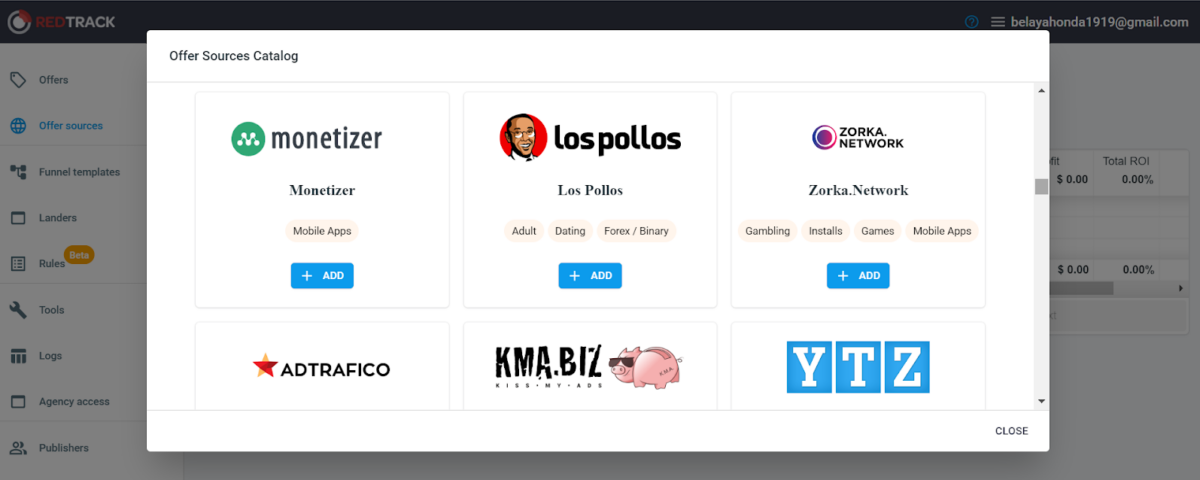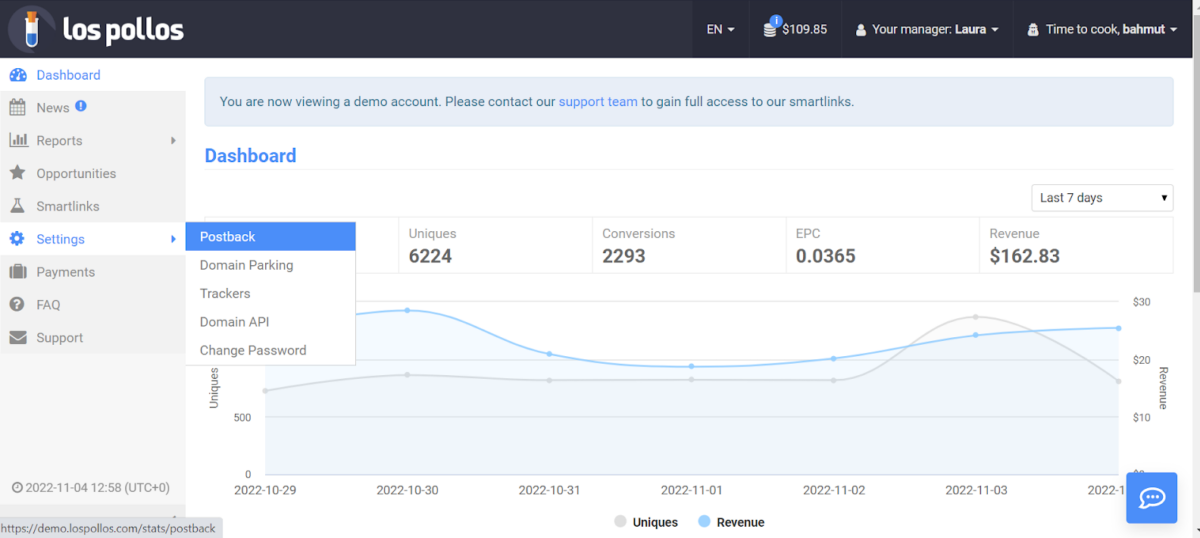
What Is postback in CPA, and how does it work
The concept of “postback” is often used in affiliate marketing. Many overlook it, as even experienced webmasters do not know what a postback request is, how to set it up, and what it provides. So far, a postback is the most reliable way to convey information about conversions within an advertising campaign.
We offer a detailed review of this feature, as you will definitely come across it sooner or later.
What Is Postback
A postback is an option that transfers traffic data from the affiliate program to the tracker. It should be noted that postback is not a mandatory affiliate parameter, but it is very handy, and that’s why LosPollos has it.
The postback allows the affiliate to get more information about the advertising campaign results and the conversions made on the advertiser’s website.
Installing postback in the affiliate program is possible only if you use third-party trackers in your work.
It would seem that if CR is reasonable, why make all this extra effort? Recall that optimization is the key to growing profit, which never happens. The more data you can collect about completed targeted actions, the easier and cheaper it is to optimize the campaign.
Why Postback Is Needed In the CPA
Setting up a postback in a CPA tracker makes it possible to track the following:
- conversion status;
- user actions on the advertiser’s website;
- conversion source;
- the effectiveness of keywords, advertisements, and campaigns;
- traffic by various parameters that affect the conversion.
We do not want to say that postback guarantees a high ROI, but it is a very effective tool, and it is a sin not to use it. If your affiliate network has this feature, you can receive and analyze information about each click. Knowing what actions are most often performed by site visitors and at what time of the day their activity is the highest will be much easier to analyze data and adjust campaign settings. For example, reduce advertising costs when it is the least effective.
Postback Mechanism
Let’s see how postback works. When the user completes the target action, his click will be assigned a click ID – a unique identifier. Every time a CPA network counts a conversion, its server sends information about it to your tracker server. You can also configure data transfer from an affiliate program or tracker to an ad network server using parameters that track conversion (macros, dynamic tags, and tokens).
You need to set up S2S tracking to display conversion data in statistics which is required for ad campaigns that use CPA Goal or have automation enabled. Simply put, a postback in affiliate programs is a link with information about leads. The important thing is that a postback URL generated in the CPA system profile will work in all active campaigns.
Postback allows you to track conversion data even in push campaigns, which is inefficient in Google Analytics since most information is lost. Therefore, the postback mechanism in affiliate marketing gives the affiliate more opportunities to analyze data than analytics services from search engines.
How to Set Up Postback in CPA Tracker
The postback setup in the tracker is completed in several stages. If you use, for example, RedTrack, you can add the LosPollos template to this tracker like so:
- Go to RedTrack, select Offer Sources in the menu on the left, and press +NEW FROM TEMPLATE
2. Find LosPollos in the list of partners and add a pre-made template +ADD.

3. You will generate the postback URL for our network, copy it and save it.
4. Further, we continue with the setup process in your LosPollos account. To set the postback URL, select the Settings – Postback tab.

And paste the link into the Global Postback URL field.
In the Smartlinks tab, select the link you want to track in RedTrack. To enable conversion tracking, add the {clickid} parameter. In this case, the direct link will be updated automatically, complete by copying it.
5. Add the LosPollos offer to RedTrack. Go to the Offers tab, add a link to the offer in the affiliate program, the macro “cid={clickid}” and the offer URL.
Save the progress to complete the postback URL setting.
These steps are needed to unify the formats in which the tracker sends data and the network receives them. Initially, they use different parameters (tags or tokens) to transfer data. Therefore, before setting up a postback, you must combine links from affiliate and advertising networks.
Where to Get Postback URL
Where to get the postback URL will depend on your affiliate program and tracker. Usually, the link is created automatically, and the webmaster does not have to do anything. Before setting up a postback, please note that affiliates can provide it at the campaign level (local postback) or at the campaign level (global). It depends on where the postback is configured – in the offer, advertising campaign, or profile settings.
Global postback is configured once and will work for all streams created within this affiliate program. Local allows you to configure data transfer for a specific stream. LosPollos provides a global postback URL.
What to Configure in Postback
MAcros, unique tags that allow you to track traffic, are used to configure postback, sorting it according to different parameters. They look like code snippets and must be referenced with an ampersand. To find out what macros the tracker supports, you need to contact the support service of your tracking system.
Depending on what information you want to receive, macros can look like this.
| {campaign_id} | Campaign ID |
| {payout} | payment for each conversion in the CPA network |
| {category_id} | teaser category ID |
| {site_category} | traffic source category ID |
| {geo} | GEO display |
| {click_id} | ID click for postback transfer |
| {status} | conversion status |
| {external_id} | ID of the traffic sent by the source |
| {stream_id} | ID stream |
| {revenue} | revenue |
| {source} | source |
| {os} | operating system |
| {os_version} | operating system version |
| {isp} | provider |
| {cost} | cost per click |
| {browser} | browser |
| {language} | browser language |
| {carrier} | Mobile service provider |
We would like to emphasize that each tracking system and affiliate network uses its own parameters. In the affiliate advertising campaign settings, they can be called macros, tags, tokens, subid. You can find them in the affiliate network documentation.
If you work with several affiliate programs, then the postback URL needs to be configured for each affiliate program. Suppose by now you have a better understanding of what a postback is and how this option works and are ready to move on to setting it up. If your affiliate program is integrated with the tracker you use, you can set up a postback for conversions in a couple of minutes. When working with a non-integrated tracker, you must manually match tokens.
Frequently Seen Errors When Setting Up Postback
Let’s look at the most frequent errors when setting up a postback and how to solve them. First, let’s say you use the Keitaro tracker, which is integrated with many affiliate programs.
If, after setting up, the tracker does not receive conversions from the affiliate program, check the correctness of the postback URL placement in the affiliate network and the data in the postback log (this can be done in the Maintenance → Logs → Received postbacks section).
If you use an offer in an advertising campaign with a redirect to a third-party host, you will most likely see an Incorrect subid error. It means that:
- the tracker receives an invalid or empty subid value. Perhaps you accidentally deleted some parameter in the template settings for this affiliate program, or the affiliate program was not selected (not created). Correct and save your changes.
- postback URL is missing in the settings. You need to find the global postback field in your affiliate program.
- if your affiliate program is not in the tracker templates, check the spelling of the macro in the field with the offer parameters. To do this, you need to determine which parameter transmits the click ID and check with what is specified in the tracker.
An empty postback log means that the postback URL from the tracker is incorrectly specified in the affiliate postback settings or missing.
Incorrect value in the tracker instead of subid – contact the account manager to check the parameter from which the affiliate pulls the click ID.
If you are using a local landing or offer in your advertising campaign, check if the postback URL from the tracker is entered correctly in the affiliate postback settings. If you see an Incorrect subid error, check if your landing page code contains a subid forwarding in the <form><form> tag (input element). There are landings in which the subid forwarding needs to be written not only in the order form but also in other files (subscribe.php, order.php, api.php). In fact, there are many options for solving the problem since each developer uses their own approach to writing code. We have shown how to often act in similar situations.
Сonclusions
Now that you know what postback is and how it works in CPA, you will probably want to try this option. If you work with our affiliate program, you can get a link in your profile right now to track ROI in your LosPollos Personal Account. You have already understood that the number of postback conversions is the most accurate information that can be used to analyze various indicators. Then it can be used in automatic optimization tools and, even more rationally, spend your budget and your own time.
